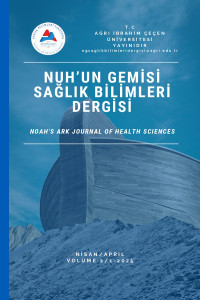Abstract
Cardiopulmonary arrest (CPA) is a phenomenon that can occur both in and out of hospital. Out-of-hospital cardiac arrest accounts for the majority of arrests treated in emergency departments. Cardiopulmonary resuscitation (CPR) refers to all interventions to restore organ perfusion caused by CPA. The first priority is to prevent the causes of arrest. On the other hand, if there are reversible causes, they should be treated and the condition that caused the arrest should be eliminated. CPA can be fatal if timely and effective CPR is not performed. Basic Life Support (BLS), the first stage of CPR, is the foundation of cardiac arrest care. BLS includes the first attempts at CPR without the use of devices. The first step in the chain of life in out-of-hospital cardiac arrest management is early recognition of the arrest and early calling for help. The steps continue with early chest compressions and early defibrillation. Recognising life-threatening irregular heart rhythms through the use of public access automated external defibrillators (AEDs) and early shock delivery also significantly reduces mortality. CPR should be continued until advanced life support is provided.
Ethical Statement
Bu çalışma için etik kurul belgesi gerekmemektedir.
Supporting Institution
Yazar(lar) araştırma için herhangi bir finansal destek almamıştır.
Thanks
Yok.
References
- Addison, A Sueta, C. (2015). Editorial (Thematic Issue: The Life Cycle of the Heart Failure Patient). Current Cardiology Reviews, 11(1), 2-3.
- Aldaas, O. M., & Birgersdotter-Green, U. (2024). Advancements in automated external and wearable cardiac defibrillators. Current Opinion in Cardiology, 40(1), 15-21. https://doi.org/10.1097/hco.0000000000001189
- American Heart Association. (2020). 2020 American Heart Association guidelines for cardiopulmonary resuscitation and emergency cardiovascular care. Circulation, 142(16), S337-S357. https://doi.org/10.1161/CIR.0000000000000916
- American Heart Association. (2021). 2021 Interim guidance to the 2020 American Heart Association guidelines for CPR and ECC. Circulation, 144(9), 202-231. https://doi.org/10.1161/CIR.0000000000001020
- Berg, K. M., Cheng, A., Panchal, A. R., Topjian, A. A., & Aziz, K. (2020). Part 7: Systems of care: 2020 American Heart Association guidelines for cardiopulmonary resuscitation and emergency cardiovascular care. Circulation, 142(16_suppl_2), 580-604. https://doi.org/10.1161/CIR.0000000000000899
- Chan P.S., Krumholz H.M., Nichol G., Nallamothu B.K.: (2008).American Heart Association National Registry of Cardiopulmonary Resuscitation Investigators. Delayed time to defibrillation after in-hospital cardiac arrest. N Engl J Med 2008; 358: 9-17.
Abstract
Kardiyopulmoner arrest (KPA), hastane dışı ve hastane içi olarak meydana gelebilecek bir olgudur. Acil servislerde müdahale edilen arrestlerin büyük bir kısmını hastane dışı kardiyak arrest oluşturmaktadır. Kardiyopulmoner Resüsitasyon (KPR) ise KPA’nın neden olduğu organ perfüzyonunu düzeltmek için yapılan tüm müdahaleleri ifade eder. İlk öncelik, arrest’ê yol açabilecek sebeplerden korunmaktır. Diğer yandan geri döndürülebilir nedenler var ise tedavi edilip arrest’e sebebiyet veren durumun ortadan kaldırılması gerekmektedir. KPA, zamanında ve etkili KPR yapılmazsa mortalite ile sonuçlanabilir. KPR’nin ilk aşaması olan Temel yaşam desteği (TYD), kardiyak arrestin temelini oluşturur. TYD, ekipman kullanmaksızın yapılan ilk müdahale girişimlerini içerir. Hastane dışı kardiyak arrest yönetiminde yaşam zincirinin ilk adımını arrest hastanın erken tanınması ve erken yardım çağrısı oluşturur. Erken göğüs kompresyonuna başlama ve erken defibrilasyon işlemi ile adımlar devam eder. Halka açık alanlarda Otomatik Eksternal Defibrilatör (OED) kullanımı ile kalpteki hayatı tehdit eden düzensiz ritimleri tanımak ve erken şok uygulaması yapmak yine mortaliteyi önemli ölçüde azaltır. TYD, ileri yaşam desteği sağlanıncaya kadar devam ettirilmelidir.
Ethical Statement
Bu çalışma için etik kurul belgesi gerekmemektedir.
Supporting Institution
Bu araştırma için herhangi bir finansal destek alınmamıştır.
References
- Addison, A Sueta, C. (2015). Editorial (Thematic Issue: The Life Cycle of the Heart Failure Patient). Current Cardiology Reviews, 11(1), 2-3.
- Aldaas, O. M., & Birgersdotter-Green, U. (2024). Advancements in automated external and wearable cardiac defibrillators. Current Opinion in Cardiology, 40(1), 15-21. https://doi.org/10.1097/hco.0000000000001189
- American Heart Association. (2020). 2020 American Heart Association guidelines for cardiopulmonary resuscitation and emergency cardiovascular care. Circulation, 142(16), S337-S357. https://doi.org/10.1161/CIR.0000000000000916
- American Heart Association. (2021). 2021 Interim guidance to the 2020 American Heart Association guidelines for CPR and ECC. Circulation, 144(9), 202-231. https://doi.org/10.1161/CIR.0000000000001020
- Berg, K. M., Cheng, A., Panchal, A. R., Topjian, A. A., & Aziz, K. (2020). Part 7: Systems of care: 2020 American Heart Association guidelines for cardiopulmonary resuscitation and emergency cardiovascular care. Circulation, 142(16_suppl_2), 580-604. https://doi.org/10.1161/CIR.0000000000000899
- Chan P.S., Krumholz H.M., Nichol G., Nallamothu B.K.: (2008).American Heart Association National Registry of Cardiopulmonary Resuscitation Investigators. Delayed time to defibrillation after in-hospital cardiac arrest. N Engl J Med 2008; 358: 9-17.
Details
| Primary Language | English |
|---|---|
| Subjects | Emergency Nursing |
| Journal Section | Reviews |
| Authors | |
| Publication Date | April 30, 2025 |
| Submission Date | September 11, 2024 |
| Acceptance Date | March 22, 2025 |
| Published in Issue | Year 2025 Volume: 2 Issue: 1 |


